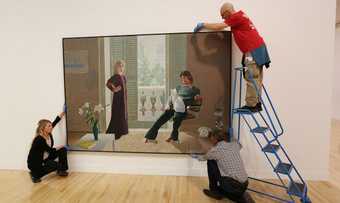
Portfolio Advice Day © Tate
Applying to courses in art or design may seem like a scary process, but if you have a portfolio of work that you are confident about, and have prepared what you are going to say, it wont be too daunting.
Application and portfolio
WHAT SHOULD I THINK ABOUT WHEN WRITING A PERSONAL STATEMENT?
‘The most common mistake is starting with the statement “Ever since I was little I have been interested in…”. We’re not after a story, it’s better to be concise and to the point. We also take into consideration transferable skills that may not be art related – things that show motivation and flexibility. This could be a team sport, travel, voluntary work or something quirky, so that we can get an idea of the spirit and personality of the student’.
Hannah Maughan, Senior Lecturer, Textile Design University College Falmouth
DO YOU HAVE ANY TIPS FOR BUILDING AND PRESENTING A PORTFOLIO?
‘Be experimental – shock, be innovative, BREAK THE RULES! Redo any work that you feel is substandard. Always keep a log of your thoughts. Keep a diary (A4/A5) that records images, sketches, thoughts and samples, cuttings of anything of interest or inspiration. Presentation is EVERYTHING’.
Roger Griffiths, Senior Lecturer, Product Design Cardiff School of Art and Design
WHAT ARE THE COMMON MISTAKES THAT APPLICANTS MAKE?
‘Little or no observational drawing in portfolios; leaving things out because they are ‘not finished’; not being clear on the application and not being fully aware of the programme they have applied for. Also not bringing sketch books, under-presenting significant items and not having thought about the good/problematic points or issues in their practice’.
Don Jackson, Senior Lecturer in Contemporary Textiles Practice Cardiff School of Art and Design
The Interview

Portfolio Advice Day © Tate
What questions can I expect at interview?
Why do you want to do this course?
- Did you attend the open day?
- Why do you want to study here?
- Do you have a favourite artist?
- What are your favourite books/magazines/films?
- What contemporary practitioner or artist inspires you?
- What are your most successful pieces of work?
- What exhibitions have you visited recently?
- Have you any ambitions of what you want to do in the future?
Is it important to always relate your work to artists and artistic contexts?
‘It’s nice to hear “this designer inspires me”, but it’s better to hear about what people have been doing, where they have been travelling, what they have seen, and how this has all influenced and informed their work. It’s about having this broader influence’.
Bryan Clark, Level 2 Head Tutor in Graphic Design University College Falmouth
‘We find that many students are unable to name a textile company or designer that inspires them which is disappointing. Make sure you do contextual research and think about less obvious artists’.
Hannah Maughan, Senior Lecturer, Textile Design University College Falmouth
What to expect: Is an art or design course the right choice for you?

Portfolio Advice Day © Tate
What is a typical timetable for a student on your course?
‘Students in whatever year treat the course as if it is a job. Taught sessions last from 9.30am – 4.30pm. There is tutor and technical support but we do encourage independent learning. Students will have a brief to work on and are expected to work in the studio rather than at home because when you’re in the studio you can make use of all the technical help, peer inspiration and the facilities available. You also learn professional practice and time management skills.’
Hannah Maughan, Senior Lecturer, Textile Design University College Falmouth
What happens when you leave art school?
‘Many graduates go on to be practising artists and designers in their field as freelancers undertaking residencies, commissions etc. Some are employed by design companies/agencies, Postgraduate study, teaching, curating, art therapy, marketing, working in museums, galleries, advertising to list a few.’
Julie Read, First Year Lecturer Edinburgh College of Art
How do you get work after art school?
‘By availing of every opportunity presented to while on the course: foreign placements, work experience, live projects, graduate showcases etc. All these experiences enrich your C.V. and put you ahead of competitors. Keep informed, check opportunity databases regularly and join associations. Do voluntary work to gain relevant experience’.
Peter Castle, Programme Director, MA Ceramics Cardiff School of Art and Design UWIC


